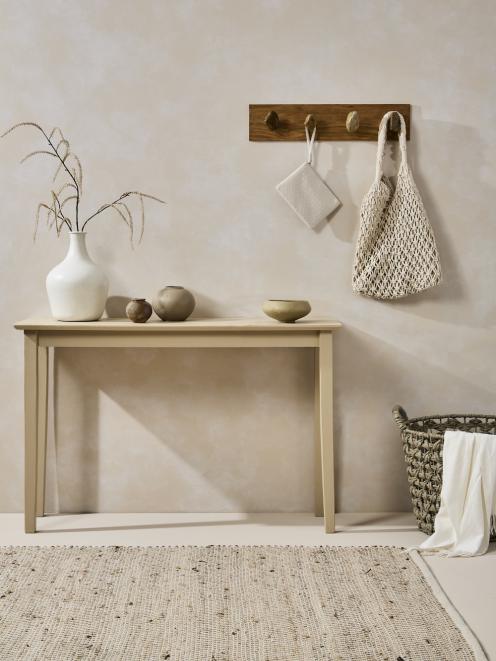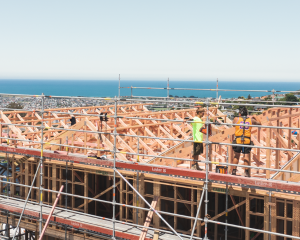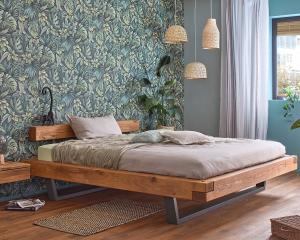
Trends like Scandi, Cottagecore or Coastal Grandma, celebrate a more authentic style that connects us to nature and focuses more on experiences than ‘things’. While that trend is still with us, it is also evolving; going deeper to pay attention to raw materials, imperfections that showcase the life something has had and the component parts that make up the looks we love.
In our own homes we are embracing this idea by reaching for materials like rope, stone and weathered wood, using textiles like felt, wool, linen and distressed leather and choosing finishes that celebrate wear and tear rather than covering it up.
The overall effect of the trend is rooms that feel loved and lived in, with an inherent warmth whether you are a sworn minimalist or a proud maximalist.
Trying it out at home
 Textured finishes such as this wall in Resene Salted Caramel with Resene FX Paint Effects Medium mixed with Resene Athena, are right on-trend and are a great way to experiment with bolder wall colours. Floor, vase and plinth light in Resene See The Light, box seat in Resene Athena and desk in Resene Meringue. (Project by Melle Van Sambeek, image by Bryce Carleton)
Textured finishes such as this wall in Resene Salted Caramel with Resene FX Paint Effects Medium mixed with Resene Athena, are right on-trend and are a great way to experiment with bolder wall colours. Floor, vase and plinth light in Resene See The Light, box seat in Resene Athena and desk in Resene Meringue. (Project by Melle Van Sambeek, image by Bryce Carleton)

Resene Colour Consultant Jackie Nicholls says the trend for showing off the textures of design materials is about celebrating the ‘perfectly imperfect’ and pulling unusual objects and finishes together to create an appealing ambience.
“Materials such as wood, clay, grass cloth, bamboo and iron all are subject to wear and tear and can be introduced into the home in creative and interesting ways.”
Some of the simplest ways to start playing with the trend for more texture that Jackie suggests are:
- Plywood for walls, which can be simply given a clear finish, stained with Resene Colorwood Natural, or given a bolder touch with darker Resene Colorwood Mahogany.
- Furniture which can be stained or colour-washed; try Resene Colorwood Japanese Maple for a Scandi finish that looks beautiful against leafy green plants or try the grey-green of Resene Colorwood Shore Thing for a washed and weathered effect.
- Vases, pots and planters distressed with chalk paint, Resene FX Crackle effect or made to look like rusted steel using Resene FX Faux Rust Effect.
Perfectly imperfect walls
 Clever use of Resene FX Paint Effects Medium gives the wall of this hallway the texture of pale stone. Other natural textures emphasise the connection to nature. The base colour is Resene Biscotti with Resene Quarter Thorndon Cream mixed with Resene FX Paint Effects Medium. Floor in Resene Biscotti, table in Resene Quarter Doeskin, vases and bowls in from left, Resene Thorndon Cream, Resene Cement and Resene Colins Wicket. (Project by Vanessa Nouwens, image by Bryce Carleton)
Clever use of Resene FX Paint Effects Medium gives the wall of this hallway the texture of pale stone. Other natural textures emphasise the connection to nature. The base colour is Resene Biscotti with Resene Quarter Thorndon Cream mixed with Resene FX Paint Effects Medium. Floor in Resene Biscotti, table in Resene Quarter Doeskin, vases and bowls in from left, Resene Thorndon Cream, Resene Cement and Resene Colins Wicket. (Project by Vanessa Nouwens, image by Bryce Carleton)

Walls with texture and layered paint effects are a really effective way to embrace the idea of imperfect wall finishes, Jackie says.
There are many ways to add texture to your walls with Resene products such as Resene FX Paint Effects medium, Resene FX Faux Rust Effect (exterior), Resene FX Crackle, Resene Resitex Coarse or Resene FX Metallic paints.
One of the most popular textured styles is a limewashed concrete style, reminiscent of Mediterranean villas or mudbrick homes. Try a muted base shade such as green-tinted Resene Secrets mixed with Resene FX Paint Effects medium in a deeper-toned green like Resene Paddock for a blended textured effect.
This type of texture finish is also a simple and effective way to add interest to neutral wall colours and evoke far-flung exotic destinations. Use it with a combination of Resene Thorndon Cream and Resene FX Paint Effects medium mixed with Resene Half Nomad.
“Popular effects at present are watercolour or ombré walls,” Jackie says, where walls feature a blurred gradient of colours.
To achieve a watercolour effect, choose a range of Resene Colorwood wood stain shades. How many depends on what finished look you are after. The look will work best on plywood or timber surfaces.
Starting with your brightest coloured stain, roughly brush the stain in random strokes onto the plywood following the grain of the timber before using a rag to rub the stain to soften the edges of the strokes. Blend duller colours into the first stain so two colours blend at the edges. Add additional coats of each chosen colour to make them appear darker. If it’s your first time trying the effect, practising on a spare piece of ply is a good idea.
Top tip: Sponging shapes in one Resene colour on to a different base colour is another way to add visual texture to a wall, as sponging will typically leave imperfect impressions. Try it in moody greys like Resene Triple Friar Greystone over Resene Quarter Friar Greystone for a textured concrete effect.
Minimalism not required
 Earthy tones elevate and celebrate the simple materials used in this dining area. Walls stained in Resene Colorwood Touch Wood, floor in Resene Creme De La Crème, door in Resene Sour Dough, tabletop in Resene Tobacco Brown with Resene Sour Dough mixed with Resene FX Paint Effects Medium for a visually textured finish. Table legs in Resene Tobacco Brown and chairs and wire bowl in Resene Bokara Grey. (Project by Melle van Sambeek, image by Bryce Carleton)
Earthy tones elevate and celebrate the simple materials used in this dining area. Walls stained in Resene Colorwood Touch Wood, floor in Resene Creme De La Crème, door in Resene Sour Dough, tabletop in Resene Tobacco Brown with Resene Sour Dough mixed with Resene FX Paint Effects Medium for a visually textured finish. Table legs in Resene Tobacco Brown and chairs and wire bowl in Resene Bokara Grey. (Project by Melle van Sambeek, image by Bryce Carleton)

Though there is a tendency to assume any design style that celebrates getting back to basics and connecting with nature, means adopting a simplified, minimalist aesthetic, that doesn’t need to be true, Jackie says.
“If you are more of a lover of luxury, you can still celebrate the simple life by introducing these natural textures in the form of organic wall coverings which are made with natural materials including reed, jute, arrowroot and cork.
“These Resene wallpaper designs offer variations in texture and colour that add a handmade aesthetic to your rooms without feeling austere.”
Resene Wallpaper Collection 38817- 5 for example, hints at veins of gold through granite, while Resene Wallpaper Collection 38829 -1 recreates the look of upcycled terracotta bricks and Resene Wallpaper Collection 38832 -1 adds the lived-in elegance of worn linen wall coverings.
Luxury in these grittier, grainier design styles can also come from the sense of quality in materials; the idea that furniture and fittings have had a good, long, useful life that can be seen in subtle wear and tear. Think of the elegantly worn furniture in a stately home, or the burnished finish of metallic fittings and old mirrors.
Natural luxury also comes in the form of textiles, like woven wool rugs or felted cushions that offer comfort and more of that hand-made feeling. Natural textures can mean rougher materials like rattan or rope, but they needn’t always be austere.
The trick to taking a simple, nature-inspired look a little further, to celebrate grain and texture, is to imagine scraping away the surface veneer to what might be underneath, however imperfect.
It might be elegant wood grains, swirls of plaster, even old hessian walls or rough concrete. Think about how you can use Resene paint and stain colour and texture to celebrate those surfaces and connect them to your furniture and fittings.
For help choosing colours, products and effects finishes to suit your projects, visit your local Resene ColorShop, ask a Resene Colour Expert online, www.resense.co.nz/colourexpert or book a Resene Colour Consultation, www.resene.co.nz/colourconsult.












